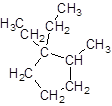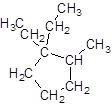
Concept explainers
a.
Interpretation:
The condensed structural formula of 1, 2-dimethylcyclopropane needs to be drawn.
Concept introduction:
When the carbon atoms of hydrocarbons are arranged in such a way that it results in the formation of ring then it is said to be cycloalkanes (containing single bond only in the ring).
a.
Answer to Problem 57A

Explanation of Solution
The given name is 1, 2-dimethylcyclopropane that means the parent chain contains cyclic ring of 3 carbon atoms and -dimethyl represents the presence of two methyl substituents at position 1 and 2. So, the structure of 1, 2-dimethylcyclopropane is:

b.
Interpretation:
The condensed structural formula of 1, 1-diethyl-2-methylcyclopentane needs to be drawn.
Concept introduction:
When the carbon atoms of hydrocarbons are arranged in such a way that it results in the formation of ring then it is said to be cycloalkanes (containing single bond only in the ring).
b.
Answer to Problem 57A

Explanation of Solution
The given name is 1, 1-diethyl-2-methylcyclopentane that means the parent chain contains cyclic ring of 5 carbon atoms and -diethyl represents the presence of two ethyl substituents at position 1 and one methyl substituent at position 2. So, the structure of 1, 1-diethyl-2-methylcyclopentane is:

Chapter 21 Solutions
Glencoe Chemistry: Matter and Change, Student Edition
Additional Science Textbook Solutions
Physics for Scientists and Engineers: A Strategic Approach, Vol. 1 (Chs 1-21) (4th Edition)
College Physics: A Strategic Approach (3rd Edition)
Applications and Investigations in Earth Science (9th Edition)
Campbell Essential Biology (7th Edition)
Chemistry: An Introduction to General, Organic, and Biological Chemistry (13th Edition)
Microbiology with Diseases by Body System (5th Edition)
- Write the law of mass action for the following quilibrium 2N2O5(g) --> 4 NO2(g) + O2(g).arrow_forwardState the products (formulas) of the reaction of acetophenone with iodine and NaOH.arrow_forwardCh. 4- Precipitation Reactions Worksheet Write balanced, complete ionic, and net ionic equations for the following reactions that mav produce precipitates. Use NR to indicate no reaction Ave 1\ +3 =6 Fe + V-2 Na S04 13. Write the balanced equation for the reaction of iron (III) phosphate with sodium sulfate to make iron (III) sulfate and sodium phosphate. 2FePO4 + M, Soy a) If you perform this reaction with 25 grams of iron (III) phosphate and an excess of sodium sulfate, how many grams of iron (III) sulfate can you make? 21 Fe 2 3x 1 Na 3 25g Fe Ingle 150,829 Indes 2 nol 3 1335 349.89 35.90 Ihol & Sanz Fez Bak heck 3x1 50ab) If 18.5 grams of iron (III) sulfate are actually made when you do this reaction, what is your Poy percent yield? 118.5 259-1-100 51.4% (0.74)x100610 335 If you do this reaction with 15 grams of sodium sulfate and get a 65.0% yield, how many grams of sodium phosphate will you make? 10.59 14. Ammonia is produced from the reaction of nitrogen and hydrogen according…arrow_forward
- == Functional Groups Identifying and drawing hemiacetals and acetals In the drawing area below, create an acetal with 1 isopropoxy group, 1 hydroxyl group, and a total of 10 carbon atoms. Explanation Click and drag to start drawing a structure. Check G +arrow_forwardState the products (formulas) of the reaction of acetophenone with iodine and NaOH.arrow_forwardExplanation Check Draw the skeletal ("line") structure of 5-hydroxy-4-methyl-2-pentanone. Click and drag to start drawing a structure. Х © 2025 McGraw Hill LLC. All Rights Reserved. Terms of Use | Privacy Cer ☐ : Carrow_forward
- 1. Using a Model set Build a model for the following compound [CH2BrCI]. 2. Build another model of the mirror image of your first molecule. 3. Place the two models next to each other and take a picture which shows the differences between the two models. 4. Determine the absolute stereochemistry R or S for the two models. 5. Write or type a paragraph to Discuss the stereochemical relationship between the two models of CH2BrCl. You must provide an explanation for your conclusions also provide a description for the colors used to represent each atom in the model's images.arrow_forwardWhat parameters are included in the specific rotation calculation of a pure substance based on measurement from a polarimeter? Select one or more: Density of the sample Pathlength of the sample container Enantiomeric excess of the sample Measured rotation of lightarrow_forwardV Determine whether the following molecule is a hemiacetal, acetal, or neither and select the appropriate box below. Also, highlight the hemiacetal or acetal carbon if there is one. Explanation O CH O Ohemiacetal Oacetal Oneither Check A 2025 McGraw Hill LLC. All Rights Reserved. Terms of Use Privacy Cer 000 Ararrow_forward
- 1. Using Online resources and chemical structures hand draw four different organic compounds (not those already shown in your handout) that are chiral, optically active (a pair of enantiomers will count as one). Pay attention to correct stereochemistry 2. Write or type a short paragraph to Discuss the stereochemical relationship between the four compounds.arrow_forward1. Using a Model set Build a model for the following compound [CHBRIF] 2. Build another model of the mirror image of your first molecule. 3. Place the two models next to each other and take a picture which shows the differences between the two models. 4. Determine the absolute stereochemistry R or S for the two models. 5. Write or type a paragraph to Discuss the stereochemical relationship between the two models of CHBгCIF. You must provide an explanation for your conclusions also provide a description for the colors used to representarrow_forwardThe specific rotation of a sample depends upon measured angle of rotation, the density of the sample, and the pathway length of the light. True Falsearrow_forward
 ChemistryChemistryISBN:9781305957404Author:Steven S. Zumdahl, Susan A. Zumdahl, Donald J. DeCostePublisher:Cengage Learning
ChemistryChemistryISBN:9781305957404Author:Steven S. Zumdahl, Susan A. Zumdahl, Donald J. DeCostePublisher:Cengage Learning ChemistryChemistryISBN:9781259911156Author:Raymond Chang Dr., Jason Overby ProfessorPublisher:McGraw-Hill Education
ChemistryChemistryISBN:9781259911156Author:Raymond Chang Dr., Jason Overby ProfessorPublisher:McGraw-Hill Education Principles of Instrumental AnalysisChemistryISBN:9781305577213Author:Douglas A. Skoog, F. James Holler, Stanley R. CrouchPublisher:Cengage Learning
Principles of Instrumental AnalysisChemistryISBN:9781305577213Author:Douglas A. Skoog, F. James Holler, Stanley R. CrouchPublisher:Cengage Learning Organic ChemistryChemistryISBN:9780078021558Author:Janice Gorzynski Smith Dr.Publisher:McGraw-Hill Education
Organic ChemistryChemistryISBN:9780078021558Author:Janice Gorzynski Smith Dr.Publisher:McGraw-Hill Education Chemistry: Principles and ReactionsChemistryISBN:9781305079373Author:William L. Masterton, Cecile N. HurleyPublisher:Cengage Learning
Chemistry: Principles and ReactionsChemistryISBN:9781305079373Author:William L. Masterton, Cecile N. HurleyPublisher:Cengage Learning Elementary Principles of Chemical Processes, Bind...ChemistryISBN:9781118431221Author:Richard M. Felder, Ronald W. Rousseau, Lisa G. BullardPublisher:WILEY
Elementary Principles of Chemical Processes, Bind...ChemistryISBN:9781118431221Author:Richard M. Felder, Ronald W. Rousseau, Lisa G. BullardPublisher:WILEY





